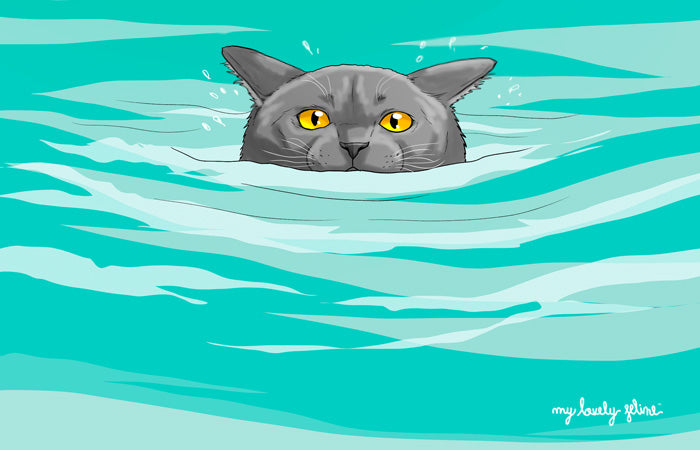—Feline Behavior Specialist 🇺🇸
|
It’s a commonly held belief that cats don’t like water, unless they’re drinking it. And if you’ve ever tried to bathe your cat, you likely agree with this statement. Many freak out once they feel the water, often flailing their limbs and splashing water all over the bathroom. There’s actually more to cats and water than what meets the eye. Let’s get our feet – or paws – wet on this topic. |
Big Cat Swimmers 🐅
Every time you look at the behavior of the domestic cat, it makes sense to reference their ancestors. While tigers win the award for the best swimmers, all big cats that live in warmer climates take dips, most likely because their bodies heat up in the sun and swimming is a great way to cool off.
Big cats that live in cooler climates, like snow leopards and pumas, tend to avoid swimming because water evaporating off their coats would make them colder.
Tigers, lions, leopards, and jaguars will also go fishing on occasion, even though fish are too small to serve as a full meal. It’s possible that after unsuccessful attacks on their favorite prey of hoofed animals, big cats still need to cool off and feed at least a little of their appetite.
It makes sense that swimming and fishing could go together and at least least hold the cat over until they’re ready to hunt on land again.
Then, there is the fishing cat.
Fishing Cat
Fishing cats are found in south and southeast Asia, and they are semi-aquatic creatures. Cats with stockier bodies are better at swimming, and the fishing cat is no different.
It also amazingly has partially webbed front toes with claws that protrude a bit even when retracted so they can easily snatch fish. Fishing cats’ fur is also different – it’s water repellent. Dense, tightly packed strands of hair prevent water from touching the cat’s skin, keeping it warm regardless of the water’s temperature.
Yes, I Can Swim
The wild cats in the dry Middle East are the closest relatives to the domestic cat. They weren’t really exposed to water besides drinking; however, all cats do instinctively have the ability to swim. Whether they actually like the water is a different story, and most find it pretty uncomfortable.
Since cats are incredible bathers, they don’t need to jump into water to get clean or to cool off. The act of bathing themselves and allowing their saliva to evaporate off their fur actually helps regulate their body temperature. Also, because of their coats, water weighs them down, and it could be difficult to swim and a scary experience for some.
Many cas do, however, love to play with water, whether it’s in their bowls, dripping out of the faucet, or while you’re taking a bath. For owners who want to get their cats accustomed to water, start exposing kittens to water and baths repeatedly so they grow up with bring in water as part of their routine.
Be sure to use lukewarm water when bathing, and limit their exposure to things like swimming pools, which are full of chemicals. And if your cat takes a swim, clean off their fur so they don’t ingest chemicals when cleaning themselves. Be sure to always wipe out their ears to prevent infections.
Cats tend to do a great job of keeping water out of their ears, but they aren’t always successful, so they’ll appreciate your help.
Domestic Cat Breeds That Love Water
Some breeds are known to actually love water, and each for seemingly good reasons:
- Turkish Van - Also known as the swimming cat, these kitties don’t have an undercoat, and have a thick, dense coat in the winter with a thinner one in the summer. Some speculate that their water-repellent coat (and desire to hunt for fish in Lake Van, Turkey) led to them enjoying water.
- Maine Coon - Like Turkish Vans, they also have a thick water repellent coat.
- Bengal and Savannah - Descendants of wild cats that like to swim (the Asian Leopard Cat and Serval), these two very social breeds love swimming.
- Norwegian Forest - These cats love to hunt for fish, and swimming is just part of catching a good meal.
- Bobtails and Manx - The Japanese Bobtail and Manx breeds were developed on islands, which is why it’s believed they like water. The American Bobtail may like water because it may be part of what’s been passed on with these tailless breeds.
- Abyssinian - These cats were on ships traveling from the Indian Ocean to Europe in the 19th century.
Just Because I Can Swim Doesn’t Mean I Want to
Obviously if your cat needs to be bathed for a specific reason, you’ll want to get them acclimated to it, but if your cat simply doesn’t enjoy water, let them be. Have a breed or a cat that loves the water? Sure, you can let them splash around a little. Keep in mind to monitor the water temperature and any chemicals in the water.
Always keep an eye on your cat and be sure to set up an easy exit for them in case their fur starts to feel weighed down. And of course, if your cat accidentally falls into water, they will most likely swim and jump out of it on their own, just don’t expect them to be happy after the experience. 🤷♀️😹
Sources
BigCatsWildCats.com, Big Cats.
Broad, Michael. Pictures-of-Cats.org, Do Wild Cats Eat Fish?.
Germantown Veterinary Clinic. GermantownVet.com, Can Cats Swim?.
MacPete, Dr. Ruth. PetHealthNetwork.coom, Do Cats Fear the Water?.
Smithsonian’s National Zoo. nationalzoo.si.org, Fishing Cat.
Article by Elizabeth Italia 🙋♀️
Cat Behavior & Fostering Specialist



